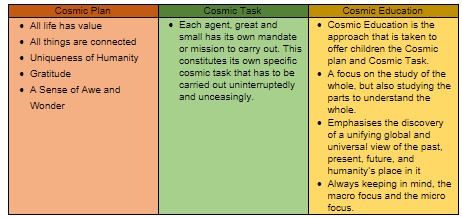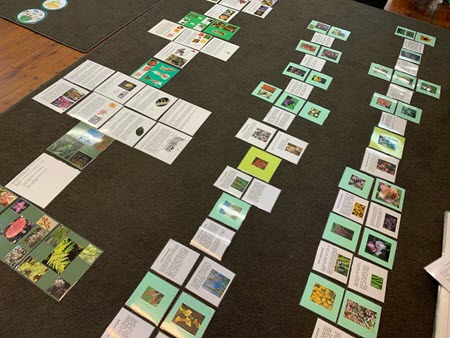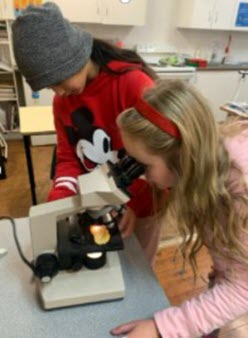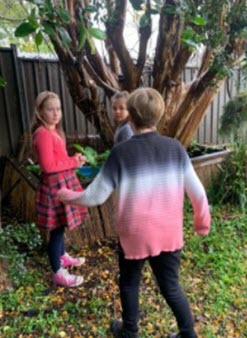What is it that makes Montessori for primary aged students different? What is it that the primary teachers plan and deliver? What do the children actually learn in the primary classrooms? Sometimes it can be a little unclear as to what is going on in the 6-9 and 9-12 classrooms. Parents receive snippets of information from Transparent Classroom. It provides them with a list of activities and how their child is progressing. Children may or may not divulge what they do on a daily basis. Parents may not fully understand the unfolding big picture of learning.
Cosmic Education
The curriculum offered in the Montessori 6 to 12 environments is called ‘Cosmic Education’. Through this curriculum, we give the children “the Universe”. We use stories, impressionistic charts, demonstrations and experiments, to enable children to “imagine reality” and stimulate the reasoning mind. This curriculum presents children with a full range of educational disciplines, including mathematics and language, as well as the arts, sciences and social sciences. The materials and exercises for each discipline area help children to build a conceptual order, and classification materials associated with each discipline helps children construct a mental order.
The theme of Cosmic Education is best summed up in the following quotation by Dr. Montessori: “The child will develop a kind of philosophy which teaches this unity of the universe; this is the very thing to motivate his interest and to give him a better insight into his own place and task in the world and at the same time presenting a chance for the development of his creative energy.”
3 big areas – Cosmic Plan and Cosmic Task transmitted to children through Cosmic Education

The educational disciplines are presented to children in the form of interconnected, interrelated and open-ended topics. The children are shown how each topic is related to other topics in the same subject area and to other subject areas. The range of the Cosmic Education curriculum is very broad, and covers topics not always offered in traditional primary schools.
Botany for children aged 6-12
As an example, let’s take a look at the Botany program to gain and insight into the content and how it links to other curriculum areas.
“If plants had a voice, they could tell us a story about themselves. Since the plants do not have a voice, I am going to tell you their story.
We are plants and we live all over the world – on the land and on the sea. We are many different kinds and we have many different colours. Some of us are soft, some hard, some smooth, some bumpy, some grow up straight, some crawl along the ground, some of us are very large, and some so small you can’t even see us. As different as we are, we all have the same three needs – water, air and minerals.
We don’t just take the things we need. We also give back things that others can use – seeds, fruits, shade, moisture, oxygen. We work very hard to perform our Cosmic Task. We try to do the best job we can.
When human beings walk through the forest we often hear them say how lovely and peaceful it is in the forest. We spend our days and nights just peacefully taking care of our own needs and doing our Cosmic Task. In order to do this, we turn our leaves up to the light of the sun. Without the light we could not survive. Sometimes one of us is in the shade of another. When this happens the shaded one just turns its leaves in another direction to catch the rays of the sun. Next time you go walking in the rainforest, look up to see how we each find our way to get enough sunlight.”
This is just a snippet of the Story of Plants which introduces the children to the Plant Kingdom. It helps children to imagine the reality of the variety and types of plants, their parts and function. The story continues on to mention how the fallen leaves become part of the soil and food for other plants, how trees fill the air with water and oxygen for animals, and the function of the roots.


Every child loves a story
Why Botany? Every child loves a story. The ‘Story of Plants’ is just one of the many stories told in the Montessori 6-12 environments. As the children ponder the story, question after question follows: “I wonder what the first plants look like?”, “Can plants move?”, “Do all plants have green leaves?” From the story framework emanates details of the discipline. The story provides an overview, the children then investigate the discipline in detail.
Biology, one of the disciplines, the life of plants and animals is a new chapter in the unfolding story of life on earth, which is part of the children’s own story. Consistent with the principals of Cosmic Education, Biology is not a subject to be studied, but a process of life unfolding that can be discovered by the child and related to other parts of the whole the universe and its furnishings.
Biology is put in a real and natural perspective to show the children that there is a mutual relationship between the earth itself and life on earth.
When the characteristics of plants and animals are put into this perspective, it becomes obvious to the children how many different needs had to be catered to by the prepared environment of the earth. Many chapters had to proceed the advent of plants and animals, and they exist together in many complex relationships with each other and with the physical environment.
Botany: Greek: botanikos, a plant
Botany is defined as the science that deals with plants, their life, structures, growth and classification. Knowing this and knowing the developing child, we need to present Botany in a manner that stimulates the reasoning and imaginative mind. Children use imagination, the reasoning mind, as well as the senses to explore, always making a hand and mind connection. From this they go beyond appearances to reasons behind visible phenomena. To be told that a leaf is green is not enough. The reasons must be given. Children must relate the function to the part, therefore giving the physiology, the way the part serves the whole. The children come to understand that the function explains behaviour. For example, leaves are part of the plant that makes food for the whole plant. They need light for this process. Therefore, they grow towards the light. It is apparent that the behaviour on the part of the plant is directly related to the function that it performs to meet the survival of the whole organism.


The teacher should be the storyteller of the truth
“Even though we all have more or less the same need for water, air, light and minerals, we can still live in many different parts of the earth and in many different types of conditions. Some of us don’t need very much water at all and we can happily live in the desert. Some of us like the water so much we live near the water. Some of us live with our feet actually in the water, and some even live under water. Some of us live where it is very cold and some of us live where it is very hot, and some of us live where it is hot some parts of the year and cold during other parts of the year. Some of us live in the forest and some live out in the open fields. Wherever we live, we exist in harmony with the earth and air. We take what we need so we can live, and we give back lots of green leaves, food, cool air, moisture for the air and shade”.
Allegory and imagery appeal to the child. The storytelling is dramatic, yet clear and simple. The whole is given first while details are added later. Charts, experiments and demonstrations support the stories and appeal to the imagination, the imagination of reality. They call children to question, and to explore, to search out other examples of phenomena demonstrated or shown.
Key lessons
Key lessons are given to arouse appreciation for plants and their respect for the diversity of their adaptive strategies, and cleverness of survival techniques. In key lessons, it is important that not all the information is given to the children. Just enough is given to stir the interest. Explorations must ultimately be motivated by the interests of the children. This exploration is the beginning of the construction of knowledge, as it challenges their minds to be flexible and unprejudiced.
Grouping plants into categories stimulates children to make use of their critical faculties and judgement; and to validate the choices made. Children build their intellect by making choices through the power of reason based on knowledge. This is the essence of scientific knowledge.




